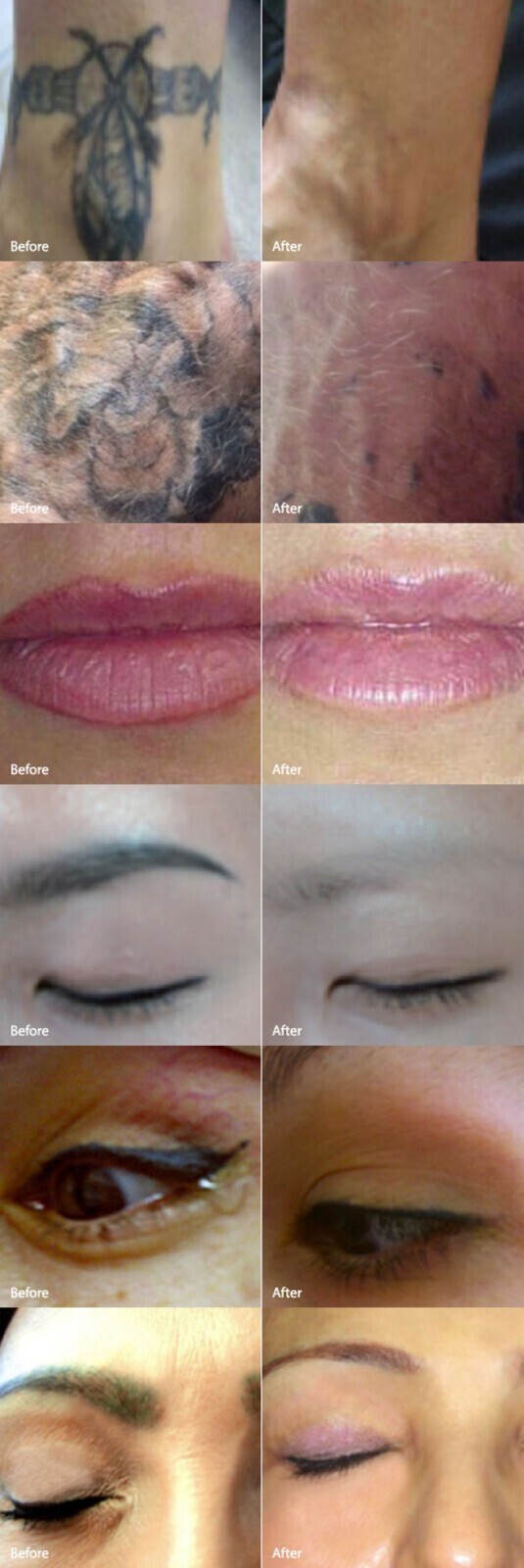Tattoo removal laser treatment. The laser treatment itself breaks up the ink particles beneath the skin. During the time allotted between treatments, the body’s natural immune system flushes away those particles, eliminating the tattoo from the skin.
Tattoo removal: Lasers outshine other methods
Has a tattoo lost its appeal? Does your permanent makeup look less attractive than you imagined?
If you’re thinking about removing either, you should know one key fact:
Lasers have largely replaced other tattoo-removal methods.
Thanks to recent advances in laser technology, today’s lasers can:
- Get rid of tattoos more safely and effectively
- Remove tattoo ink with fewer treatments
- Treat ink colours that were once difficult to remove
Treatment
The market for effective tattoo removal has grown greatly over the last ten years. Tattoos are created by injecting coloured pigment into deep, small holes made in the skin. Until the discovery of lasers, dermabrasion and surgical excision were the only methods of removing these relatively permanent tattoos. These methods were invasive and posed a big risk for side effects and infection.
In the last decade, laser systems have been developed and improved to safely and effectively remove pigment from the layers of the skin. A tattoo is a denser form of pigment, one that is artificial compared to freckles and dark spots. If tattoos are to be removed properly, only tried and tested technology must be used. Among these, the Pastelle Q-switched Nd:YAG laser are the Gold Standards in their class.
What is it and how does it work?
During treatment, fast pulses of light from the Pastelle are directed on the tattoo, breaking up the pigment molecules into smaller particles. Tattoo ink and natural pigmentation, like melanin in freckles, absorb these Q-switched pulses so quickly that they create a photo-acoustic effect within the pigment clusters without harming any of the normal tissue surrounding the pigment. This effect breaks down the ink into much smaller particles that are eventually removed by the body’s natural filtering system.
Q-switched Nd-Yag laser has been the ultra-reliable and cost-effective system of practitioners all over the world in the last decade.

Results achieved using the Pastelle Q-Switch
What are the possible side effects of laser tattoo removal?
Some people develop light or dark spots on their skin. These spots tend to disappear within 6 to 12 months.
Other side effects are rare when performed by a dermatologist who uses lasers. When someone lacks medical training, the following side effects are more common:
- Scarring
- Changes to the skin’s texture
- Burns and other wounds
Is laser tattoo removal safe for everyone?
Most people can safely have laser tattoo removal. There are a few exceptions. You need a healthy immune system for laser tattoo removal to work. And, women who are pregnant or breastfeeding should not be treated.
Does laser tattoo removal hurt?
Laser tattoo removal can feel uncomfortable or painful. To prevent discomfort and pain, a dermatologist can give you a numbing cream or shot.
When can I do another treatment?
Generally one will need from 3-5 sessions.
After laser tattoo removal, you may see some redness, swelling, and a little blistering.
After each treatment, your tattoo should lighten.
Treatments are fortnightly to allow skin to heal and body to eliminate broken down particles of ink.
To give you a better understanding of what to expect from laser tattoo removal, speak to our experienced medical staff about what is most suitable for you.
